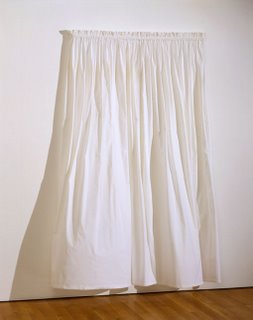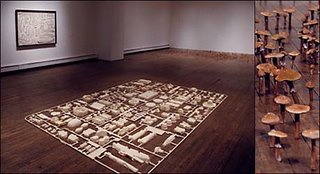inner self- the sense of losing and finding oneself at the same time
the lasting impact of one's own immediate experience.
discovering highly personal connections with objects.
gasps of aesthetic response
works that have taken my breath away, brought my hand to my heart, summoned forth and aaahhhh from deep within.
Joy of discovering for yourself what a work of art might mean to you and to you alone?
Childeren haven't lost that ability, but we as adults have apparently abandoned that experiential and personal way of looking at art.
Today our interaction with the visual arts seems to be driven primarily by our culture's obsession with "meaning".
Throw into the equation our increasingly fast-paced life, and you might find yourself wondering why anyone would take the time to look at comtemprorary art anymore.
when we experience a great deal of ugliness or beauty, a great deal of fear or love, a great deal of loneliness or intimacy.
Beaury, of all things, would appear to have been the icebreaker. Approached berudgingly at first and with great suspicion, beauty is now readily accepted as a serious topic for discussion.
Agnes Martin-Our emotional life is really dominant obver our intellectual life, but we do not realize it.
Trascendence.
The verb "to transcend" means to rise above or to go beyond the limits of.
The adjective "transcendent" means extending beyond usual limits-surpassing, exceeding.
The noun "transcendece" is defined as the quality or state of being transcendent, of having gone beyond the limits of ordinary expereince.
The German painter Caspar David Friedrich(1774-1840) , a pioneer in the Romantic movement, showed us with his meditative landscapes how "all earthly parts, whether humble or exalted, lead to the unknown."
_> Barnett Newman, Mark Rothko, and Ad Reinhardt
Since Frost has long contended that "Poetry is simply made of metaphor" ("saying one thing and meaning another, saying one thing in terms of another, the pleasure of ulteriority"
the self surrendered to the sublimity of the non-self
we hear and listen to silence.
we revel in stillness.
irreducible, non-discursive experience
Scans have pinpointed which areas of our brain go into high gear and which become dormant when we hava such an experiece, and studies how how we can "instruct" our brain to allow for htis differenct awareness.
It could be the smile, damp eyes, and speechlessness of a visitor who approaches you and squeezes your arm after a profound encountering.
intensity.
This is not the view from back at command central, or from an ivory tower, but from donw where objects and people meet face to face.-humanity
elements including nature, time, perception, allegory, the sensorium, essence, color and memory.
Early in the 19th century, "The Romantics believed that the simplest forms of Nature could speak directly to us, could express sentiments and ideas without the intervention of culture; they dreamed of creating through landscape an art both personal and objective, an immediate, nonconventional, universally intelliglble experssion, a language that would not be discursive but evocative."
Psychologist Kames Hillman, "Beauty cannot enter art unless the mind in the work is anchored beyond itself so that in some way the finished work reflects the sacred and the doing of the work, ritual."
technosublime
Ray's reductivist Roating circle(1988) looks at first glance as if the artist simply drew a circle on the wall, a Minimalist gesture indeed. But if you move in for a closer look, you are rewarded with the discovery that it isn't a drawn circle at all, but a disk, seemingly cut right out of the wall, that is spinning around.
Altman's snowhead, which taps into everyone's childhood memories, whether real or culturlly imprinted. Through the window of a freezer, we peer in and see a snowman with coal eyes, a jaunty carrot nose, and a wide grin. Preserved only fro th emoment, destned ultimately to melt, Altman's snowman reminds us of how we hold on to and often treasure such fleeting memories.
poetisphere
Marcel Proust, "involuntary memory"
-At age twenty-two, he was already tormented by the thought of temps perdu. His early writings resonate with the idea of time as a haunting nightmare. He was introduced to Henri Bergson's view that there are two different ways of considering time: there is time that vanishes into nothingness and time that endures. "Enduring-time" (temps-duree) is psychological time. It is the nonmeasurable, qualitative experience in which the present continuously augments the past without obliterating it."
Proust began to see "inner time," a reality filled with our feelings and emotions, as very different from "chronometric time." "The past," he wrote, "still lives in us . . . has made us what we are and is remaking us every moment! . . . An hour is not merely an hour!" (the Proustian image). "It is a vase filled with perfumes, sounds, places and climates! . . . So we hold within us a treasure of impressions, clustered in small knots, each with a flavor of its own, formed from our own experiences, that become certain moments of our past.
Yet, Proust realized, we cannot reach this treasure, which is buried in our subconscious mind. "Time past" is lost to us, but the sensations experienced are not: here is an inexhaustible mine for art.
When we give our memory an order to bring back a fragment of our past (our "voluntary memory"), it can only suggest the factual data or the skeleton; but the original flavor of the scene will be left behind. This flavor is the "priceless everything" to an artist, making a moment in time unique.
Unusual experiences led Proust to "the truth of involuntary memory," the basis for his life's work. The famous incident of the petit madeleine revealed to him a past lying dormant within him, ready to be called back to consciousness. He was able to retrieve "a feeling of inexplicable happiness" when his mother offered him the little plump cake. He was illuminated by a childhood memory (of Combray), where his Aunt Leone on Sunday mornings used to give him a madeleine, dipping it first in her own cup of tea. It "all sprang into being, town and garden alike, from my cup of tea!"
How to explain when, from the past, "nothing seems to subsist, the smell, sound, and taste of things remained. And it is these sensory experiences that bear unfaltering the vast structure of recollection!"
Proust thus uncovered a form of memory, beyond the control of our consciousness. Recollection is suggested by some unexpected physical sensation (perhaps unimportant in itself) such as a faint scent, taste, or sound. But that sensation has in the past been associated with a number of definite impressions, and when by chance the identical sensation recurs years afterwards, all the impressions (associated with it) also rush back, en masse. "It is a complete fragment of the past, with its original 'perfume,' that is for a moment given back to us." Resurrection of the past as the aftermath of an accidental, involuntary physical sensation is the keystone of Proust's conception of life and art. It combines past and present.
Proust's artistic engagement with memory intersects in many ways with what science has learned about the mechanics of memory. The physiology of Proust's petit madeleine experience is well understood. The olfactory system, for instance, has a direct, evolutionarily primitive connection to the hypothalamus not shared by other sensory systems, which gives odors a special power to trigger memories in some detail. His work also anticipates modern psychological findings on the degree to which memory is reconstructive, "fleshing out" the details of a remembered scene anew each time it is recalled, the memory itself being merely an "outline.
(http://72.14.209.104/search?q=cache:b4JObRbq-PYJ:www.secularhumanism.org/library/fi/lowen_22_4.htm+Marcel+Proust,+%22involuntary+memory%22&hl=en&gl=us&ct=clnk&cd=5&client=safari)
We cam experience knowing without naming and being to understand what philosopher George Santayana(1863-1952) meant "To feel beauty is a better thing than to understand how we come to feel it."
Piet Mondrian "a nostalgia for the universal"
The universal in art requires active participation.
It requires breaking away from passive scceptance of institutional or academic doctrine, and becoming personally involved with a work of art.
Poet Ralph Waldo Emerson(1803-1882) called upon individuals to join in just such a journey of discovery: "The foregoing generations beheld God and nature face to face; we through their eyes. Why should not we also enjoy an original relation to the universe? Why should not we have a poetry and a philosophy of insight and not of tradition, and a religion by revelation to us, and not the history of theirs?"
own original relation to the universe
to know the self both lost and found,
to feel the astonishment of being
the raw actuality of existence
the immediacy of life



